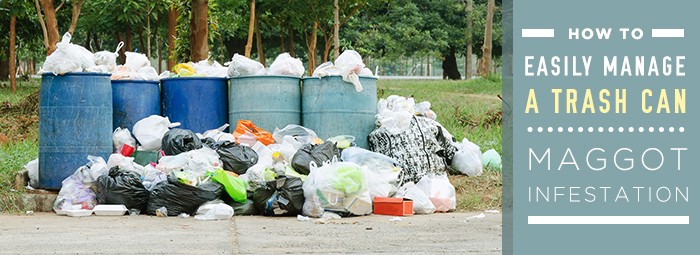
Emptying the trash should be a seamless, dependable process, with little interruption in your daily routine. But when unwelcome visitors take up residence in your trash cans, it?s important to arm yourself with a strategy and to act quickly to assure a stress-free routine in the future. The dreaded sighting of tiny white bugs is a sure sign of maggot infestation. This causes immediate discomfort and anxiety in many people, but there are clear ways to nip the issue in the bud before any distress is necessary.
Understanding Maggot Infestations

Before a common house fly takes flight, it remains in its larva stage ? the maggot. Flies will seek out warm, protected spaces to lay their eggs. This way, when the larva hatch, they are in close proximity to an ideal food source. Using their apt sense of smell to determine their preferred environment, maggots often travel toward contained areas of rotting food. So it is common for an infestation to take place in your garbage can.
A trash can full of food remnants, especially meat, is a prime spot for growing larva. As the warmer weather arrives, the heat enhances the food?s odor, increasing the maggot?s chances of spotting the can as a prime home. Since a female fly can lay between 500 and 2,000 eggs during her one-month lifetime, it is important to catch the issue early on, as maggots can multiply exponentially as time progresses. Thankfully, there are clear methods laid out for preventing this.
Taking Action
Although maggots can be tricky to catch, knowing a few dependable methods will eliminate all apprehension when the unfortunate situation arises. The first involves ensuring that your cans are completely sanitized and clear of any larva or possible food remnants. You can achieve this in the following ways:
Boiling Water
Carefully pour boiling water down the inner sides and base of the trash can. Once you?ve done this, be sure to fully dry the inside of the barrel, as maggots are likely to return to humid and damp environments.
Freezing
With smaller infestations, collect the maggots and place them in an airtight container. Placing them in the freezer overnight is a more peaceful way to end the issue.
Bleach
Dilute one cup of bleach with one cup of water, and delicately swirl the liquid around the can to sanitize the surface. Rinse with water and dry thoroughly.
Vinegar and Water
For a more natural approach, mix one-part vinegar and three-parts boiling water before disinfecting the can with the solution. This both cleans the surface and removes the fly-attracting odors.
Insecticide
When seeking an insecticide to rid yourself of maggot issues, be sure to seek out a brand that contains permethrin. A thorough spray around the surface of the can should do the trick. It is important to use caution with this chemical, though, as it is safe for humans and dogs but highly toxic to cats.
Diatomaceous Earth
This dynamic material, created from the fossilized material of phytoplankton, is nontoxic to humans but has the ability to dry out and eliminate certain bugs. This is another natural approach to consider when eradicating maggots.
Learn how to keep maggots from reappearing in your trash can on the Trashcans Unlimited blog: How to Manage a Trash Can Maggot Infestation


